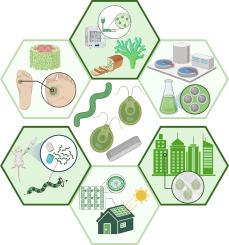Biotechnology Advances ( IF 12.1 ) Pub Date : 2022-05-21 , DOI: 10.1016/j.biotechadv.2022.107988 Anna Dawiec-Liśniewska 1 , Daria Podstawczyk 2 , Anna Bastrzyk 2 , Krystian Czuba 2 , Kornelia Pacyna-Iwanicka 2 , Oseweuba Valentine Okoro 3 , Amin Shavandi 3

|
As a source of several valuable products, photosynthetic microorganisms (microalgae and cyanobacteria) have many applications in biomedical, electrochemical, and urban-space fields. Microalgal and cyanobacterial (photoautotrophs) implementations have been the subject matter of several reviews, which mainly focused on exploring effective methods of their harvesting, optimal cultivation conditions, energy conversion efficiency, and new strategies for microalgal health-promoting compound recovery. This review highlights recent investigations into biomedical, urban, environmental, and electrical engineering microalgae and cyanobacteria applications over the last seven years. A brief historical outline of advances in photoautotroph-based technologies is presented prior to an exploration of the important role of these microorganisms in combating global warming and food and energy insecurity. Special attention is given to the photosynthetic oxygen production of algae and the possibility of treating hypoxia-associated diseases such as cancer or tissue injuries. Photoautotroph applications in microrobotics, drug delivery and wound healing systems, biosensors, and bioelectronics are also introduced and discussed. Finally, we present emerging fabrication techniques, such as additive manufacturing, that unleash the full potential of autotrophic, self-sufficient microorganisms at both the micro- and macroscales. This review constitutes an original contribution to photoautotroph biotechnology and is thought to be impactful in determining the future roles of microalgae and cyanobacteria in medical, electrical, or urban space applications.
中文翻译:

光合微生物生物技术应用新趋势
作为几种有价值产品的来源,光合微生物(微藻和蓝藻)在生物医学、电化学和城市空间领域有许多应用。微藻和蓝藻(光合自养生物)的实施已成为几篇评论的主题,主要集中在探索其收获的有效方法、最佳培养条件、能量转换效率以及微藻促进健康的化合物回收的新策略。这篇综述重点介绍了过去七年来对生物医学、城市、环境和电气工程微藻和蓝藻应用的最新调查。在探索这些微生物在应对全球变暖以及粮食和能源不安全方面的重要作用之前,简要介绍了基于光合自养技术的进展。特别关注藻类的光合作用产氧和治疗缺氧相关疾病(如癌症或组织损伤)的可能性。还介绍和讨论了光自养在微型机器人、药物输送和伤口愈合系统、生物传感器和生物电子学中的应用。最后,我们展示了新兴的制造技术,例如增材制造,这些技术可以在微观和宏观尺度上释放自养、自给自足的微生物的全部潜力。











































 京公网安备 11010802027423号
京公网安备 11010802027423号